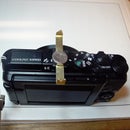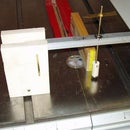Introduction: Bench Top Dynomometer
A dynamometer is usually defined as a device for measuring mechanical power, but in a broader sense can include measurement of force and torque also. In this Instructable we will build a dynamometer to measure torque and power of a small electrical motor. First we will measure the motor's torque with a Prony brake, which applies friction to a rotating motor shaft. Next, we will calculate power output. This requires knowing the RPM of the motor at the moment the torque is measured. Power is then easily calculated: Power = RPM x Torque.
Step 1: Build the Prony Brake
The Prony brake is a device invented in 1821 by French engineer Gaspard de Prony to measure torque produced by an engine . The most basic type is a lever, which includes a clamp that can be tightened around a shaft; as the clamp is tightened, the friction increases. The resulting torque is calculated by multiplying the force measured at the end of the shaft by the shaft length: Torque = Force x Distance.
The Prony brake for our dynamometer is made from 2x3 lumber that clamps around a 3/8" steel shaft. The main lever arm is 28" long, the clamp (top part) is 6" long. The lever arm is symmetrical around the shaft so that it is balanced. The clamping piece is held loosely by two wood screws at one end; at the other end is a 3/8" carriage bolt and wing nut which is used to adjust clamping force. Attach the two parts and drill a 5/16" hole at exact center.
Step 2: Make the Shaft Support and Attach the Prony Brake
The Prony brake clamps around a shaft which is driven by the motor. The steel shaft is 3/8" diameter x 12”, and is supported by two 3/8" ID x 1/2" OD brass bushing bearings which are pressed into 1/2" holes in plywood bearing stands (see photo). The holes in the clamp direct cooling water to the shaft, which can get very hot. This heat is due to the mechanical energy from the motor being converted to thermal energy.
Parts list:
The parts are specified in the steps, but you can make adjustments to meet your needs. Basically, you will need a shaft and bearings. A larger shaft (1/2" diameter) would be fine, but do not use a shaft smaller than 3/8" diameter. Bronze bushing bearings are fine if you keep them oiled. Everything else in the project is plywood and fasteners. All hardware is available from a hardware store.
Tools:
Ordinary shop tools, including a drill press, will be needed. A scale is needed to measure force, and a non-contact (laser type) tachometer to measure RPM.
Step 3: Motor Setup
Since various size motors will be tested, the base should accommodate different shaft height. The steel shaft in the photo is exactly 4" above the plywood base. So to mount this DC motor which has a 2 1/2" shaft height, a wood riser is built to bring the two shafts to same height. Align the shafts with a straight edge. The shaft coupling in the photo is admittedly makeshift but works surprisingly well . This shaft coupling is a piece of 3/8" ID compressed air hose, clamped over the shaft with hose clamps.
Step 4: Testing Setup Complete
The testing procedure is to start the motor with very little clamping force; then measure the force on the scale and read the RPM with a non-contact tachometer such as the one shown in the intro photograph. Increase the clamping force, take another RPM and force reading. Continue doing this until you have recorded 10 or 12 readings. Shut off the motor immediately after each reading; the shaft will be getting HOT! Drip some water into the holes to cool the shaft.
Safety precautions:
- You should only test fractional horsepower motors, this setup is not suitable for large or high RPM motors.
- Friction will be heating the shaft, run motors for short periods only and keep water nearby to cool the Prony brake.
- You should be familiar with electricty and mechanical equipment.
Step 5: Equations and Calculations
Here are the concepts:
- Torque = Force x Distance
- Power = Torque x RPM
And here are exact equations:
- Horsepower = Torque x RPM/5252, where torque is measured in pound-feet
- Kilowatts = Torque x RPM/9550, where torque is measured in Newton-meters
- Horsepower = kW x 1.34
- Kilowatts = HP x 0.746
- Newtons = Kilograms x 9.8
Step 6: Plot the Data (or Just Caculate Power)
This chart shows the results from a test on a 115v AC drill press motor. But if you just want to know the power output of the motor, you can use the equations from the previous step. You actually need just one torque measurement to come up with a reasonably accurate power calculation for an AC motor. Here is a sample calculation, using data from test of a :
Nameplate rated RPM: 1720
Nameplate rated power: 1/4 HP
Actual test data, torque at 1720 RPM: 0.42 pounds-ft = 1.36 Newton-meter
HP = Torque x RPM/5252 = 0.42 x 1720/5252 = 0.14 HP
KW = Torque x RPM/9550 = 1.36 x 1720/9550 = 0.25 kW
The test results were 0.14 HP, nameplate HP 0.25 HP. That is a "reasonable" comparison, given the power losses in the shop-made dynamometer and the tendency of motor manufacturers to be a bit generous in their claims.
If your AC motor has no nameplate data, measure the torque at 95% of the maximum RPM.
The chart shows a plot of torque and power data versus RPM for the example motor. Note that at the rated RPM of 1720, the power output is about 0.14 HP, which is the normal operating point of the drill. However, with increasing torque applied, RPM decreases but power continues to increase. Yes, that is exactly what happens when you lug down the motor and try to dill a larger hole in hardwood, for example. There should be some reserve power for these situations, but you are overloading the motor; it will heat up and eventually the circuit breaker will trip.
Step 7: Chart of Test Data for 12v DC Motor.
This is a plot of RPM vs. torque and horsepower for a test on a 12v DC motor (the motor shown in Step 3). Note that the chart looks a lot different than the chart for a AC motor.

Participated in the
Workshop Contest







![Tim's Mechanical Spider Leg [LU9685-20CU]](https://content.instructables.com/FFB/5R4I/LVKZ6G6R/FFB5R4ILVKZ6G6R.png?auto=webp&crop=1.2%3A1&frame=1&width=306)





